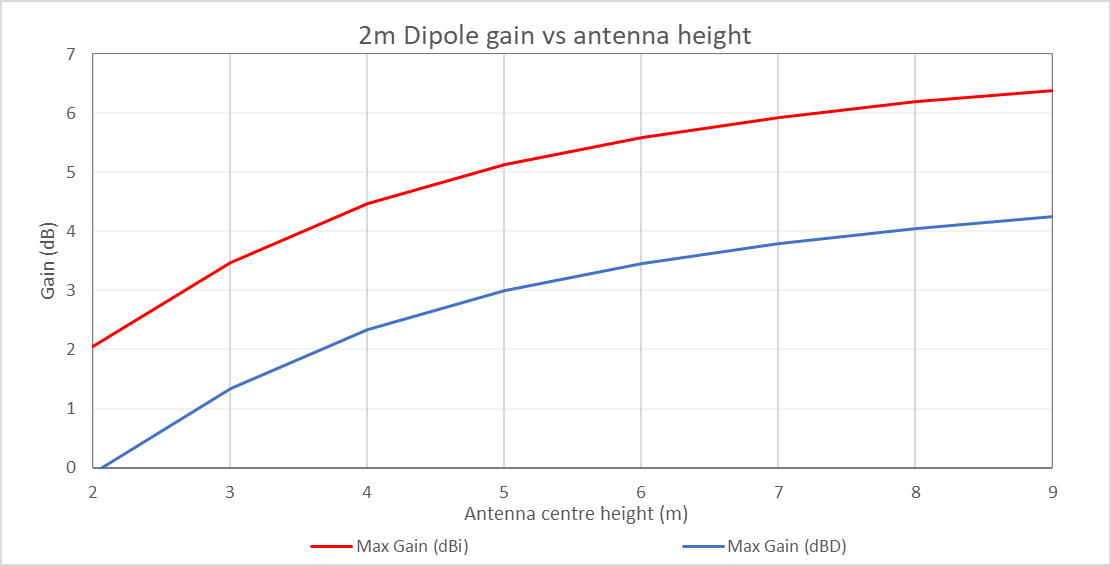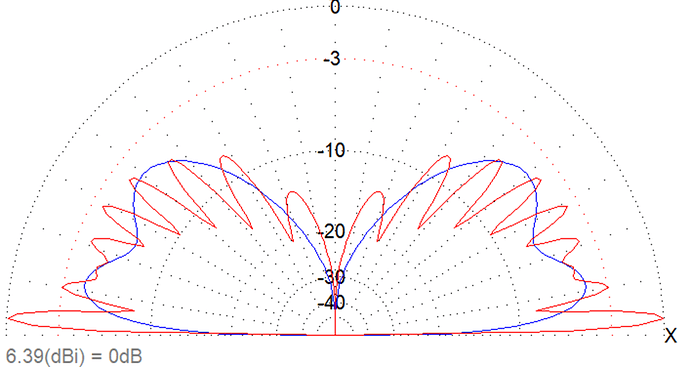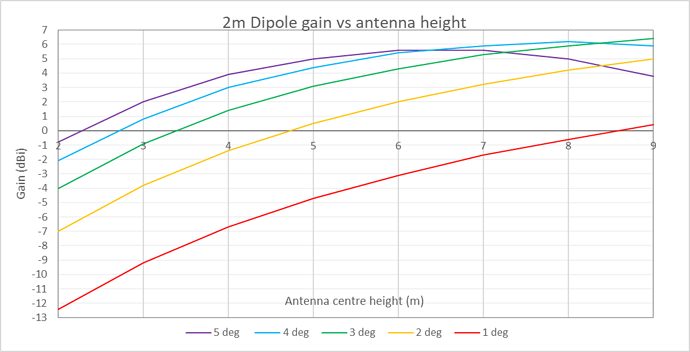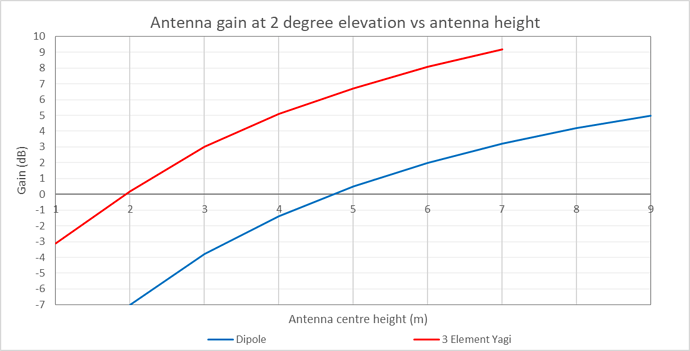Why did I bring this big, heavy, pole when life is so much easier with a SOTAbeams Tactical Mini?
I read through the SOTA Reflector and found Richard G3CWI’s response to a similar question:
So, I set about modelling a centre-fed half-wave vertical dipole at 145.500mhz in MMANA. As is often the case, each answer prompts more questions.
The gain and far field plot of a dipole is well known, with it beautiful doughnut shaped bubble of RF, radiating to the horizon, and a gain of 2.14dBi, but my dipoles are not in free space. I chose to model the dipole over ‘Real Ground’ using the default MMANA parameters (Dielectric Const = 13.0, Conductivity = 5.0 mS/m).
The chart below presents theoretical antenna gain versus antenna centre height above ground level and shows that there is 4.25dB increase in maximum gain by lifting the antenna from 2m to 9m (the top of a 10m pole).
But this isn’t the full story. The far field elevation plot below presents 2 antennas: 2m height above ground (blue), and 9m height above ground (red). As the antenna height increases the far field pattern splits into multiple lobes, and the elevation angle of the lowest lobe (max gain) drops.
Next, I plotted the theoretical gain at specific take off angles versus height. Raising the dipole from 2m to 9m creates a predicted 12dB increase in low angle radiation, so height is important!
The far field plots present the radiation relative to the ‘ground’ and it is worth noting that the angle of the dipole to the vertical appears to have no significant effect on the far field plot.
What I do not know is the relationship between the far field plot and the terrain on a specific summit, or the actual take-off angle during a VHF contact between 2 stations. Looking back at the elevation plots, there are not many degrees difference between the elevation angle for maximum gain and the first null. The higher we place our antenna, the lobes become narrower, and the actual take off angle becomes more critical. Similarly, achieving gain with a colinear or 5/8 antenna creates a narrow lobe and the same risk. Is there a sensible limit to the benefits to be gained for the height of a dipole on a SOTA summit?
Is it worth taking my 3 element Yagi to a SOTA activation? Choosing an arbitrary 2 degree elevation angle for comparison, I modelled the predicted maximum gain of the Yagi versus a dipole at various heights.
In still to calm conditions, with good guying, I can support a Yagi 7m above ground level on a SpiderBeam 10m pole. Comparing this to a dipole at the top of the same pole (9m), the Yagi offers a potential 4.2dB advantage at 2 degree take-off, much less than I had hoped. I only have to drop the Yagi to 4m before the dipole offers comparable low angle gain.
Comparing a handheld Yagi at 1m with a dipole at 5m, there is a 3.6dB penalty for using the Yagi, when modelled at a 2 degree take off angle. There may be other reasons to use a directional antenna other than just to increase gain, maybe nulling out strong signals, maximising signal to noise ratio, or direction finding, (Edit: but I can’t see a reason to use a handheld Yagi on a SOTA summit) but there does not appear to be a benefits from using a handheld Yagi at 1m height with the ground conditions used in this model. Many highly regarded activators, with lots of real world experience, can testify to the benefits of using a Yagi at low heights. This may be due to ground conditions and topography on a summit being very different from what was modelled. (End of edit)
Interestingly, the front to back ratio of the Yagi actually increases slightly when it is close to the ground, reinforcing that reassuring and satisfying impression that it is working as you rotate it towards the other station.
Putting all of this into perspective:
- Fantastic antennas are not an essential part of a great activation.
- I have not struggled for 2m contacts on the summits that I have visited.
- I have been able to complete several QSOs with my pole collapsed on the floor.
- 6dB is only around 1 S point on the radio.
- I admit to enjoying antenna modelling just for the sake of trying to understand what is going on.
My thoughts are so far:
- I will use a simple dipole (Flowerpot or SlimJim) at the top of a 6m pole as my default antenna for 2m FM.
- I will only take my 10m pole if I am attempting S2S or DX, and think that I will benefit from a potential 3-5dB of additional low angle gain.
- I will leave my Yagi at home except for calm, sunny days on summits with a short walk in.
What are your thoughts?
Can anyone point me to an article that explains the effect of terrain on take off angle (edit) for vertical polarisation?
73 Kevin




